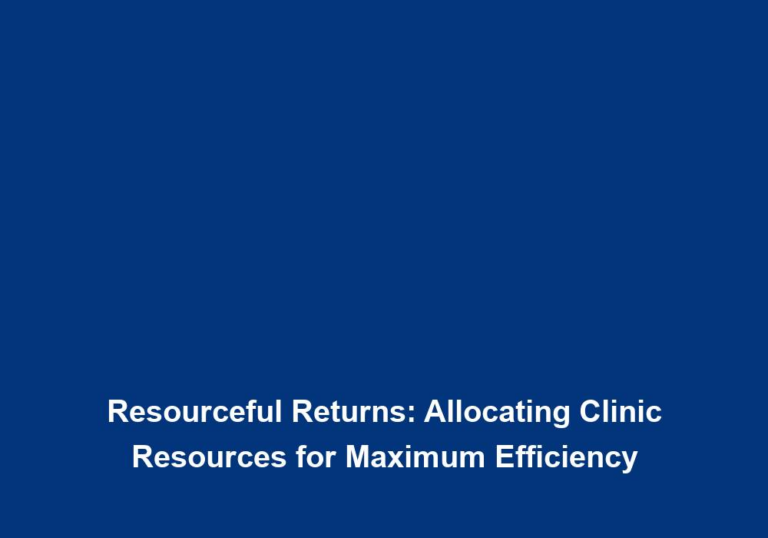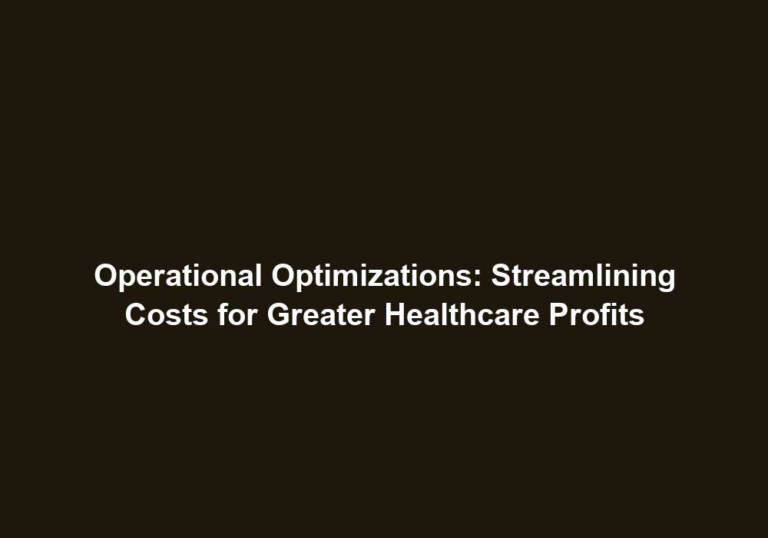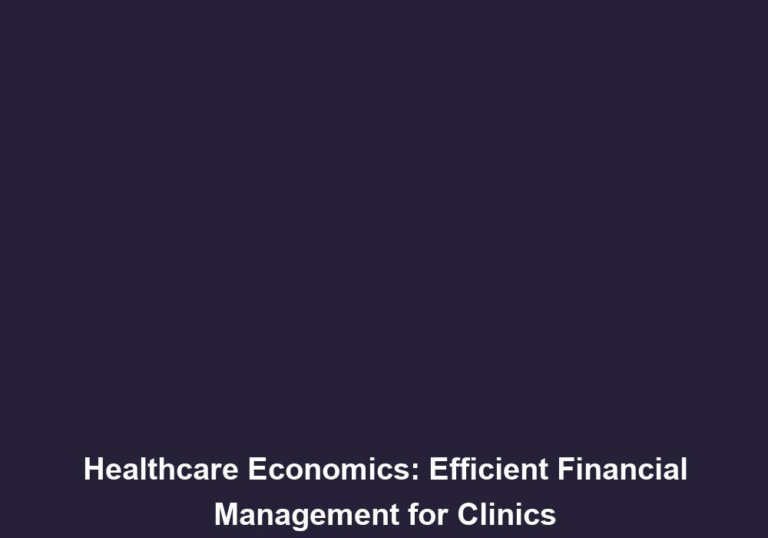Efficiency Equals Savings: Financial Cost-Cutting Techniques for Clinics
In today’s competitive healthcare landscape, clinics and medical facilities are constantly looking for ways to improve their operational efficiency while reducing costs. Finding effective cost-cutting strategies not only helps clinics maintain their financial stability but also enables them to provide better patient care. This article explores various techniques that clinics can implement to achieve financial savings without compromising on quality.
1. Optimize Staffing Levels
One significant area where clinics can achieve efficiency and cost savings is through effective staff management. Evaluating and optimizing staffing levels based on patient volume and demand can help clinics avoid overstaffing, which can lead to unnecessary expenses. On the other hand, understaffing can compromise patient care and satisfaction. By closely monitoring patient flow patterns and adjusting staffing accordingly, clinics can strike a balance and ensure optimal utilization of human resources.
Expanding on this topic, clinics can consider the following strategies to optimize staffing levels:
- Conduct regular staff performance evaluations to identify areas for improvement and provide necessary training.
- Implement flexible scheduling options to accommodate fluctuating patient volumes and prevent understaffing or overstaffing.
- Utilize data analytics tools to analyze patient flow patterns and predict staffing needs accurately.
By implementing these strategies, clinics can not only optimize their staffing levels but also improve overall operational efficiency and reduce costs.
2. Embrace Technology
Incorporating technology into clinic operations can have a profound impact on efficiency and cost reduction. Implementing an electronic health records (EHR) system helps eliminate the need for paper-based records, reducing storage costs and improving accessibility. Additionally, leveraging scheduling software can streamline appointment booking processes, reducing administrative burdens and improving patient flow.
Expanding on this topic, here are some additional ways clinics can embrace technology to achieve cost savings:
- Integrate telemedicine platforms to offer remote consultations and virtual visits, reducing the need for physical space and associated overhead costs.
- Adopt mobile apps or patient portals for secure communication, appointment scheduling, and access to medical records, improving convenience for both patients and healthcare providers.
- Implement data analytics tools to identify areas of inefficiency, such as bottlenecks in patient flow or resource utilization, and make data-driven decisions for process optimization.
By fully embracing technology, clinics can not only improve operational efficiency but also enhance the patient experience while reducing costs.
3. Streamline Supply Chain Management
Effective supply chain management is crucial for clinics to optimize costs and minimize waste. By evaluating vendors and negotiating favorable contracts, clinics can secure competitive pricing for medical supplies and equipment. Implementing inventory management systems ensures that clinics maintain appropriate stock levels, reducing the risk of overstocking or stockouts.
Expanding on this topic, here are some additional strategies to streamline supply chain management:
- Collaborate with vendors to establish just-in-time inventory systems, minimizing storage costs and reducing the risk of expired or obsolete inventory.
- Implement automated reorder systems based on real-time usage data, ensuring a continuous supply of critical items while minimizing manual intervention.
- Conduct regular vendor performance reviews to assess reliability, quality, and pricing, allowing clinics to make informed decisions about supplier partnerships.
Furthermore, exploring group purchasing organizations (GPOs) can provide clinics with collective buying power, resulting in more significant cost savings. GPOs negotiate contracts with suppliers on behalf of multiple healthcare facilities, allowing clinics to benefit from volume discounts and favorable terms.
By implementing effective supply chain management practices, clinics can reduce costs, eliminate waste, and ensure a reliable supply of essential medical resources.
4. Reduce Administrative Costs
Administrative costs often account for a significant portion of a clinic’s expenses. Implementing efficient administrative processes can lead to substantial cost savings. Here are some strategies to consider:
- Automate repetitive tasks: Utilize software solutions to automate tasks such as appointment reminders, billing, and claims processing. Automation reduces the need for manual intervention and saves valuable time and resources.
- Centralize administrative functions: Consolidating administrative functions, such as billing and coding, into a centralized department eliminates redundancy and improves efficiency.
- Outsource non-core tasks: Consider outsourcing non-core functions like transcription services, IT support, or medical billing to specialized service providers. This approach can help reduce overhead costs and allow the clinic’s staff to focus on core patient care activities.
Expanding on this topic, clinics can also implement the following measures to further reduce administrative costs:
- Implement electronic payment systems to streamline billing processes and reduce paperwork.
- Utilize cloud-based document management systems to eliminate the need for physical storage space and improve document accessibility and security.
- Train staff on efficient administrative practices and continuously evaluate processes for potential improvements.
By implementing these strategies, clinics can significantly reduce administrative costs, streamline operations, and allocate resources more effectively.
5. Implement Energy-Efficient Measures
Energy expenses can be a significant financial burden for clinics. Implementing energy-efficient measures not only helps reduce costs but also contributes to environmental sustainability. Consider the following energy-saving techniques:
- Upgrade lighting systems: Replacing traditional light bulbs with energy-efficient alternatives, such as LED lights, can lead to substantial energy savings over time.
- Improve insulation: Proper insulation helps maintain optimal temperature levels within the clinic, reducing the need for excessive heating or cooling. This leads to significant energy savings.
- Invest in energy-efficient equipment: When purchasing new equipment, opt for energy-efficient models. Look for ENERGY STAR® certified devices, which are designed to consume less energy without sacrificing performance.
Expanding on this topic, clinics can take additional steps to implement energy-efficient measures:
- Install motion sensors or timers to control lighting and HVAC systems, ensuring energy is not wasted when areas are unoccupied.
- Conduct energy audits to identify areas of energy inefficiency and implement targeted solutions, such as sealing air leaks or upgrading HVAC systems.
- Educate staff on energy-saving practices, such as turning off lights and equipment when not in use, and encourage a culture of sustainability within the clinic.
By implementing energy-efficient measures, clinics can significantly reduce energy expenses and contribute to a greener environment.
6. Maximize Revenue Generation
While focusing on cost-cutting measures, clinics should also explore avenues to maximize revenue generation. Here are a few strategies to consider:
- Optimize reimbursement processes: Stay updated with the latest coding and billing guidelines to ensure accurate reimbursement for services provided. Proper documentation and coding practices can help avoid claim denials or underpayments.
- Expand service offerings: Consider offering additional healthcare services that align with the clinic’s expertise and patient needs. This can attract new patients and generate additional revenue streams.
- Implement patient education programs: Educating patients about preventive care measures and promoting wellness initiatives can help reduce the frequency of expensive treatments and hospital visits. This not only improves patient outcomes but also leads to cost savings in the long run.
Expanding on this topic, clinics can also implement the following strategies to maximize revenue generation:
- Develop partnerships or collaborations with other healthcare providers to offer comprehensive care packages or specialty services.
- Implement effective patient retention strategies, such as loyalty programs or personalized follow-up care, to enhance patient satisfaction and encourage repeat visits.
- Leverage digital marketing techniques, such as search engine optimization (SEO) and social media marketing, to attract a wider audience and increase brand visibility.
By implementing these revenue maximization strategies, clinics can offset costs and achieve financial stability while maintaining high-quality patient care.
By implementing these cost-cutting techniques, clinics can enhance their overall efficiency and achieve significant financial savings. It is important to continually assess and reassess operations to identify areas for improvement and adapt to the ever-evolving healthcare landscape. Efficient clinics can not only provide better patient care but also ensure their long-term sustainability in a highly competitive industry.
Note: This article is written in markdown format for easy integration into various digital platforms and content management systems.







